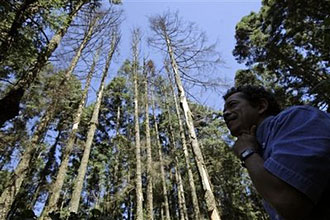
|  |  |  Editorials | Environmental | October 2009 Editorials | Environmental | October 2009  
Mexico Fells Trees to Save Butterfly Reserve
 Mark Stevenson - Associated Press Mark Stevenson - Associated Press
go to original
October 20, 2009


| | In this photo taken Oct. 16, 2009, Rosendo Caro, Director of Mexico's Monarch butterfly reserve, stands in front of a group of trees severly damaged by the bark beetle, outside of the reserve near Ocampo, Mexico. (AP/Gregory Bull) |  |
Mexico City – Authorities who have struggled to stop illegal logging in Mexico's famed monarch butterfly reserve now are cutting down thousands of trees themselves to fight an unprecedented infestation of deadly bark beetles.

Biologists and park workers are racing to fell as many as 9,000 infected fir trees and bury or extract infested wood before the orange-and-black monarchs start arriving in late October to spend the winter bunched together on branches, carpeting the trees.

Environmentalists say the forest canopy of tall firs is essential to shelter the butterflies on their annual migration through Mexico, the United States and Canada. The journey is tracked by scholars and schoolchildren across North America and draws tens of thousands of tourists to the reserve, a U.N. Heritage site.

But freezing rains and cold night air that can kill the monarchs at the high-altitude reserve, so the insects are threatened by a loss of trees, whether by loggers or the bark beetles.

Because the migration is an inherited trait — no butterfly lives to make the round-trip — it's not clear whether they could find another wintering ground.

Experts say insecticide is the best way to control the beetles, but that would endanger the butterflies. Instead, park officials are fighting the plague tree-by-tree.

"It is obvious that in the medium and long term, if we do not act to adapt to the changes, then there could be a serious risk" to the butterflies' migration, said reserve director Rosendo Caro, a forestry expert. "The forest is not going to disappear, but the conditions that make up the right environment for the wintering phenomenon could disappear."

Beetles are devastating forests across the continent from Colorado to the Yukon, killing millions of acres (hectares) of trees. In most places, the infestation is spurred by trees weakened by drought, and beetles that thrive in warmer weather. The dead trees increase the risk of forest fires, exacerbating the problem.

Bark beetles have long been present in the reserve monarch reserve, usually attacking a few trees in the driest months of early spring, before heavy seasonal rains that normally start in May. But this year, little rain had fallen by July, and the trees were weakened. The beetles took advantage, burrowing in and robbing the trees of nutrients until they turned orange and die.

The infestation so far has affected 100 of the 13,550 hectares (33,482 acres) in the reserve's core mountaintop wintering grounds.

But experts are concerned because the outbreak is occurring in patches, indicating the infestation is spreading. And a Mexican government report on climate change predicts more late or delayed summer rains, with a 15 percent decline in overall rainfall between now and 2080.

If the bark beetle attacks become a regular occurrence and more trees are felled, Monarch expert Lincoln Brower worries there could be more "holes in the blanket" of the tree canopy that protects the butterflies.

Diana Six, a professor of forest entomology and pathology at the University of Montana, said the best way to protect trees is to spray their bases with the pesticide Carbaryl, but "you can't use it if you've got Monarchs coming in, because it's a general pesticide; it kills everything as far as insects."

So Mexican officials face the time-consuming task of cutting down each infested tree, removing the bark, burying it under soil, and then taking away the wood to prevent the beetles from spreading. Once the butterflies are back, the work must stop.

Caro said he thinks authorities have caught the problem in time this year.

The die-off comes just as authorities were making headway against illegal logging. Since 2006, armed police have patrolled to combat logging gangs and aid for the mountain villages that dot the reserve has helped reduce tree loss.

A report by the World Wildlife Fund and Mexican environmentalists found that deforestation in the reserve declined by about 44 percent, falling from about 460 hectares (1,136 acres) in 2005-2006, to 260 hectares between 2007 and 2008. Mexican officials say they would like to curb it even further, but the problem is mainly confined to one small area.

Still, the prospect of reserve officials cutting down trees worries some longtime defenders of the oyamel fir forest, like Brower.

"There is a frequent ploy to justify cutting oyamels and pines by claiming bark beetle infestation," he noted.

Felipe Martinez, a biologist working on the anti-beetle effort, says "not a single piece of wood" will be moved out of the reserve unless environmental authorities authorize it. |

 |
|  |



